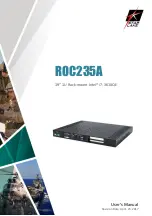
3510/3510KP/3512/3512KP System Manual
3-22
System Power
Using isolation transformers on the incoming AC power line to the system is always
a good practice. An isolation transformer is especially desirable in cases in which
heavy equipment is likely to introduce noise onto the AC line. The isolation
transformer can also serve as a step-down transformer to reduce the incoming line
voltage to a desired level. The transformer should have a sufficient power rating
(units of volt-amperes) to supply the load adequately.
Proper grounding is essential to all safe electrical installations. Refer to the relevant
Federal, State/Provincial, and local electric codes which provides data such as the
size and types of conductors, color codes and connections necessary for safe
grounding of electrical components. The code specifies that a grounding path must
be permanent (no solder), continuous, and able to safely conduct the ground-fault
current in the system with minimal impedance (minimum wire required is 18 Awg, 1
mm).
Observe the following practices:
•
Separate ground wires (P.E. or Protective Earth) from power wires at the point of
entry to the enclosure. To minimize the ground wire length within the enclosure,
locate the ground reference point near the point of entry for the plant power supply.
•
All electrical racks or chassis and machine elements should be Earth Grounded
in installations where high levels of electrical noise can be expected. The
rack/chassis should be grounded with a ground rod or attached to nearby Earth
structure such as a steel support beam. Each different apparatus should be
connected to a single Earth Ground point in a “star” configuration with low
impedance cable. Scrape away paint and other nonconductive material from the
area where a chassis makes contact with the enclosure. In addition to the ground
connection made through the mounting bolt or stud, use a one-inch metal braid
or size #8 AWG wire to connect between each chassis and the enclosure at the
mounting bolt or stud.
Excessive Heat
The units withstand temperatures from 0º to 50ºC. The systems are cooled by
convection, in which a vertical column of air is drawn in an upward direction over
the surface of its components. To keep the temperature in range, the cooling air at
the base of the system must not exceed 50°C. Allocate proper spacing between
internal components installed in the enclosure.
When the air temperature is higher than the specified maximum in the enclosure, use
a fan or air conditioner to lower the temperature.
Electrical Noise
Electrical noise is seldom responsible for damaging components, unless extremely
high energy or high voltage levels are present. However, noise can cause temporary
malfunctions which can result in hazardous machine operation in certain
















































